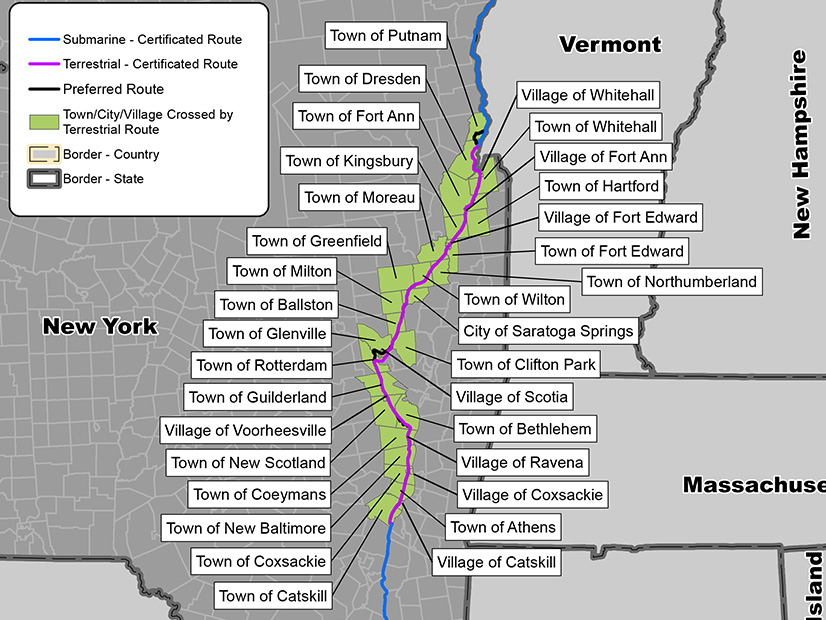New York officials are considering a plan to increase the capacity of the proposed Champlain Hudson Power Express (CHPE) line by 25%, from 1,000 MW to 1,250 MW.
The state’s Public Service Commission on Wednesday held a public hearing on the proposed change to the $3 billion HVDC line, which would run 330 miles between Quebec and New York (Case No. 10-T-0139).
Environmentalists told the state Public Service Commission that the project would harm rivers in New York and Canada, while a union supported the infrastructure investment and the jobs it creates. A navigation expert expressed interest in participating in technical deliberations on how deep to bury the cable.
The line was first proposed by Blackstone’s Transmission Developers Inc. (TDI) in 2010 and has so far united environmentalists and power producers in opposition to it, according to comments received earlier this year by the PSC. (See Enviros, Generators Oppose Canadian Hydro Line to NYC.)
Asked why Hydro-Québec would not be defending itself in the proceeding, company spokesperson Lynn St-Laurent told RTO Insider that “HQ has had opportunities to discuss the merits and attributes of our hydropower with a variety of stakeholders. … In this case however, the PSC will be hearing testimony on an amendment to authorize an increase in the nameplate capacity of the CHPE transmission line project … [and] therefore such comments about HQ or its energy are not pertinent to the matter at hand.”
Speaking at a Columbia University webinar Monday, Hydro-Québec CEO Sophie Brochu did not address CHPE directly but did say that communicating with customers is the No.1 challenge facing energy companies today.
“Let’s take New York,” Brochu said. “We believe at Hydro-Québec that we have a great contribution to make, but we don’t view ourselves in competition with the offshore wind into your neck of the woods.”
New York City will “need everything,” including local offshore wind, onshore wind, solar and storage, “all hands on deck,” Brochu said. “Balance it as you wish … but if it costs a fortune, the people will go bankrupt and the citizens will be angry because the taxes will go through the roof.”
Mixed Response
Representing the grassroots Solidarity Committee of the Capital District, Tom Ellis of Albany said the group has opposed the CHPE project since it was first proposed in 2010.
“The CHPE transmission line would damage the Hudson River and likely lead to additional river destructions in Quebec and Labrador,” Ellis said. “This proposed 25% increase [in capacity], combined with all the route changes approved last year by the PSC, should trigger federal and state orders that the developers prepare a new environmental impact statement.”
John Lipscomb, a patrol boat operator and advocate for Hudson Riverkeeper, and a voting member of the Hudson River Safety, Navigation and Operations Committee, called for study to determine if the electromagnetic frequencies resulting from the 25% increase have impacts on migrating fish, especially the severely endangered Atlantic sturgeon.
With tankers and barges carrying many different toxic cargoes, from oil to asphalt to ethanol, the safety committee is concerned that the bury depth of the cable has been permitted at six or seven feet instead of the customary 15 feet recommended by the U.S. Coast Guard, Lipscomb said.
Shipping industry representatives have long been “waving a red flag” that a bury depth of seven feet will not prevent the cables from being snagged by the flukes of their anchors if they are forced to anchor in an emergency, he said.
“The track of the cable is still to be determined, and details like the bury depth are in draft form still to be finalized … and we’d like to see the commercial operators on the river involved in the final bury depth and routing deliberations,” Lipscomb said. “Once an accident happens on the Hudson, cleanup is going to be virtually impossible … and the best way to save the Hudson is not to have an accident.”
Daniel Ortega of the Engineers Labor-Employer Cooperative (ELEC 825) said, “We represent over 8,000 union members and over 1,000 signatory contractors in the Hudson Valley and New Jersey… and we proudly support the CHPE project.”
The innovative CHPE project will supply New York City with enough renewable energy to power one million homes and will create 1,000 construction jobs and an additional 1,100 indirect jobs during its nearly four-year construction period, Ortega said.



